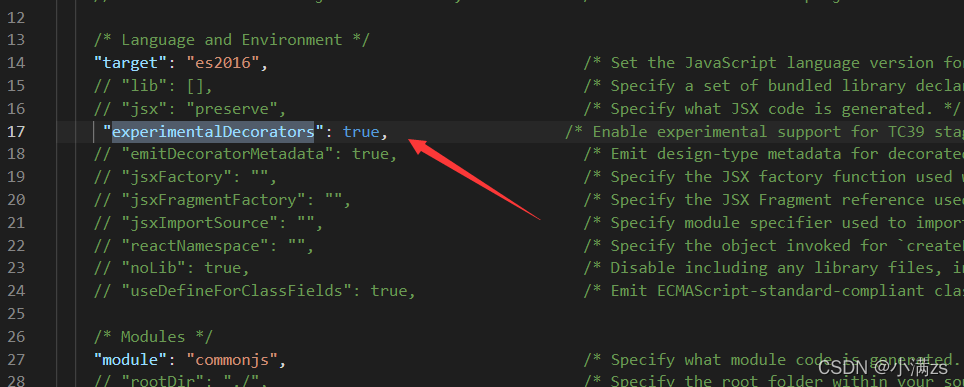装饰器 Decorator
Decorator 装饰器是一项实验性特性,在未来的版本中可能会发生改变
它们不仅增加了代码的可读性,清晰地表达了意图,而且提供一种方便的手段,增加或修改类的功能
若要启用实验性的装饰器特性,你必须在命令行或 tsconfig.json 里启用编译器选项

装饰器
装饰器是一种特殊类型的声明,它能够被附加到类声明,方法, 访问符,属性或参数上。
类装饰器
ts
class A {
constructor() {}
}定义一个类装饰器函数 他会把 ClassA 的构造函数传入你的 watcher 函数当做第一个参数
ts
const watcher: ClassDecorator = (target: Function) => {
target.prototype.getParams = <T>(params: T): T => {
return params;
};
};使用的时候 直接通过@函数名使用
ts
@watcher
class A {
constructor() {}
}验证
ts
const a = new A();
console.log((a as any).getParams('123'));装饰器工厂
其实也就是一个高阶函数 外层的函数接受值 里层的函数最终接受类的构造函数
ts
const watcher = (name: string): ClassDecorator => {
return (target: Function) => {
target.prototype.getParams = <T>(params: T): T => {
return params;
};
target.prototype.getOptions = (): string => {
return name;
};
};
};
@watcher('name')
class A {
constructor() {}
}
const a = new A();
console.log((a as any).getParams('123'));装饰器组合
就是可以使用多个装饰器
ts
const watcher = (name: string): ClassDecorator => {
return (target: Function) => {
target.prototype.getParams = <T>(params: T): T => {
return params;
};
target.prototype.getOptions = (): string => {
return name;
};
};
};
const watcher2 = (name: string): ClassDecorator => {
return (target: Function) => {
target.prototype.getNames = (): string => {
return name;
};
};
};
@watcher2('name2')
@watcher('name')
class A {
constructor() {}
}
const a = new A();
console.log((a as any).getOptions());
console.log((a as any).getNames());方法装饰器
返回三个参数
- 对于静态成员来说是类的构造函数,对于实例成员是类的原型对象。
- 成员的名字。
- 成员的属性描述符。
ts
[
{},
'getData',
{
value: [Function: getData],
writable: true,
enumerable: false,
configurable: true
}
]ts
const Get = (url: string) => {
const fn: MethodDecorator = (
target,
propertyKey,
descriptor: PropertyDescriptor
) => {
console.log(target, propertyKey, descriptor);
descriptor.value('我是传入的参数');
};
return fn;
};
class Http {
constructor() {}
@Get('http://www.baidu.com')
getData(data: any) {
console.log(data, '传入的参数被打印');
}
}
const http = new Http();属性装饰器
返回两个参数
- 对于静态成员来说是类的构造函数,对于实例成员是类的原型对象。
- 属性的名字。
- [ {}, 'name', undefined ]
ts
const met: PropertyDecorator = (...args) => {
console.log(args);
};
class A {
@met
name: string;
constructor() {}
}
const a = new A();参数装饰器
返回三个参数
- 对于静态成员来说是类的构造函数,对于实例成员是类的原型对象。
- 成员的名字。
- 参数在函数参数列表中的索引。
- [ {}, 'setParasm', 0 ]
ts
const met: ParameterDecorator = (...args) => {
console.log(args);
};
class A {
constructor() {}
setParasm(@met name: string = '213') {}
}
const a = new A();元数据存储
ts
// 存取值需要用到这个库
import 'reflect-metadata';可以快速存储元数据然后在用到的地方取出来 defineMetadata getMetadata
ts
//1.类装饰器 ClassDecorator
//2.属性装饰器 PropertyDecorator
//3.参数装饰器 ParameterDecorator
//4.方法装饰器 MethodDecorator PropertyDescriptor 'https://api.apiopen.top/api/getHaoKanVideo?page=0&size=10'
//5.装饰器工厂
import axios from 'axios';
import 'reflect-metadata';
const Base = (base: string) => {
const fn: ClassDecorator = target => {
target.prototype.base = base;
};
return fn;
};
const Get = (url: string) => {
const fn: MethodDecorator = (
target: any,
key,
descriptor: PropertyDescriptor
) => {
axios.get(url).then(res => {
const key = Reflect.getMetadata('key', target);
descriptor.value(key ? res.data[key] : res.data);
});
};
return fn;
};
const result = () => {
const fn: ParameterDecorator = (target: any, key, index) => {
Reflect.defineMetadata('key', 'result', target);
};
return fn;
};
const Bt: PropertyDecorator = (target, key) => {
console.log(target, key);
};
@Base('/api')
class Http {
@Bt
xiaoman: string;
constructor() {
this.xiaoman = 'xiaoman';
}
@Get('https://api.apiopen.top/api/getHaoKanVideo?page=0&size=10')
getList(@result() data: any) {
//参数装饰器要优先于方法装饰器执行,所以在参数装饰器中存入元数据,方法装饰器中就可以取出来
// console.log(data)
}
// @Post('/aaaa')
create() {}
}
const http = new Http() as any;
// console.log(http.base)